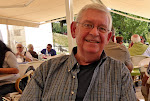Here's what I wrote about that incident on my Saint-Aignan blog:
Speaking of terrorism and security issues, Walt and I were stopped by the police today in the Albany NY suburb where we are staying. We had gone out for a walk around our friends' neighborhood at about 10:30 a.m., and I was of course taking pictures. A lot of the houses are very beautiful, and they are very different from houses in France. Somebody called the police and reported me as a suspicious character. The policeman actually ran my ID through the police department computer to see if I was legitimate! He told me I could go on my way but that I shouldn't take any more pictures of houses. Do you think it's really illegal to take pictures when you are on a public right of way in America? Has it come to this? Are people this paranoid?Walt's grandmother told me yesterday that there was a gruesome axe murder in this suburb last year, and that the police pretty much botched the case. A young man killed his father and maimed his mother. He has been convicted, even though his mother refuses to believe her son is guilty. I guess some people in town are still nervous, and the police force is over-zealous as a result.
The policeman wasn't even polite or apologetic about it. It's creepy here. Not Albany, America. I don't like what's happened.
We arrived in Albany last Thursday night. Friday afternoon we went downtown to see the NY state government complex known as the Empire State Plaza. The first thing we did was ride the elevators up to the top floor observation deck of the 40-storey Erastus Corning Tower to get the lay of the land and take some photos.
Albany's city hall is the brown, red-rooved building with the square tower on it. It's just at the edge of the state government complex.
From the observation deck where I took this picture, there are views to the north, east, and south. This picture looks north. In the foreground is the building called "the egg," which is a performing arts center. The capitol is the building with red rooves, and off in the distance you can sort of see the Adirondack Mountains on the horizon.
Looking straight down from the top of tower, you see the famous New York logo. Not to mention a lot of freeways and cars.
The cathrdral is just south of the Empire State Plaza, which was built in the 1960s and '70s. A large neighborhood was razed to make space for the Plaza in the center of the city. I think that neighborhood had been home to a lot of immigrants from Italy and other parts of Europe.
Expanses of land and concrete devoted to automobile parking are a characteristic of American cities nowadays. There are parking lots in French towns and cities too, but not on this scale. South of the cathedral in Albany is a parking lot. The car defines the American city in a way it does not define European cities.
Walt says these big air vents are designed to let wind in to blow the pollution out of the big parking garages used by state workers.
The old South End neighborhood is separated from the Hudson River by an impressive network of highways. In this picture, the fall colors are nice. There are a lot of vacant lots where houses have been demolished. I don't think the South End is a particularly prosperous district.
The buildings in the South End have a lot of potential, but people don't want to live there any more, I guess. A lot of the old houses are boarded up.
This is a nice piece of street art. It's painted on a boarded up window in downtown Albany.
Lombardo's is an Albany institution, I think. We didn't try the restaurant, at least not yet.
Albany is a beautiful place in many ways, as you can see from these pictures. It's a small city that, compared to cities in the U.S. South and West, hasn't suffered a lot of suburban sprawl and development.
Of course, Albany has been losing population for years. A lot of people from the U.S. Northeast have been moving to places like the Carolinas and Florida and Arizona and California. As a result, my home state, North Carolina, for example, has changed and developed rapidly. The population has doubled since the 1960s. With all the good and the bad that that entails.












No comments:
Post a Comment